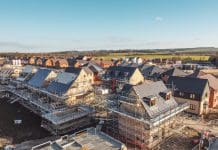Peter Barker, director of BIM Academy, assesses the current digital climate and the drive towards sustainable buildings
The drive towards sustainable buildings is escalating rapidly and this can be attributed to a number of factors which are having a major impact on the AEC industry globally, particularly the collective sense of urgency about carbon induced climate change, wasted energy and resources.
Since the late 2000s, the application of BIM on construction projects has enabled the enhanced reliability and interpretation of information for critical design decisions regarding a building’s predicted performance and its environmental impact in use.
However, the provision and utilisation of such information has yet to be exploited to its full potential, given that in many instances there is a disconnect between BIM methodologies, sustainable design practices and traditional procurement workflows. This often leads to the postponement of critical decisions until too late in the process.
Differing perceptions and misaligned expectations of the benefits and outcomes of BIM and sustainable design adoption need to be addressed, and quickly.
Sustainability now needs to become the key driver for the digital transformation of the built environment and addressing the challenges of climate change is a pressing agenda for us all.
Opportunities for convergence
There is a mutually supportive alignment between digital construction and sustainability and, when combined, they form an unbreakable connection, one which will prove powerful in the fight against climate change.
It is important for us, as an industry, to exchange ideas about this subject as it has such a vital role to play in the future of our industry and the societies we serve, not just for our own regions, but on a global scale.
Keen to understand what action is being taken on this at a global level, I recently spoke to several sustainability champions to uncover what other regions outside of the UK have been doing to address blending digital construction and sustainability. One such expert I reached out to was Helen Goodland, founding principal and head of research and innovation at Scius Advisory, a research, consulting and innovation intelligence firm based in Vancouver, Canada, that specialises in state-of-the-art technical and policy research and delivering transformative solutions for the construction industry.
Environmental action in Canada
Helen serves on Canada’s National Zero Waste Council’s Construction Taskforce and on the board of CanBIM – Canada’s voice for the effective deployment of digital technologies and processes in the building and infrastructure industry.
She told me about the digital built environment in Canada and what positive steps have been taken within the construction industry for this region to tackle carbon emissions and reduce unnecessary waste.
We know that two of the world’s largest contributors to global warming are construction and the embodied carbon of building materials and, as such, I asked Helen, how do we send a clear message to the construction industry things need to change?
Helen responded that most people in construction recognise this need to change, we are the last great analogue industry and this is no longer fit for purpose, we need to do more, and move quickly.
I am presently based in our Vancouver office and have come to understand that for British Columbia and Canada, a key sustainability theme, underpinned by an ambitious legislative programme, is the drive towards high performing, highly energy efficient buildings, the conservation of resources and the minimisation of waste. In this region, as in many others, margins are slim (and getting slimmer), and everyone is seeking more for less. Which is why we need to identify new areas of efficiency and how to implement them quickly. Many of us understand the why we need to change, but we fall down at the how to change.
From my conversation with Helen and what I’ve learned from working with our team in Vancouver is that a large proportion of construction businesses in British Columbia have fewer than 10 employees, for them digital can prove to be the key to being more agile and competitive. We are operating in a fiercely competitive industry which can be divisive, but digital can be a greater leveller and give smaller organisations a competitive edge.
One in 10 Canadians work in construction and in British Columbia the population has a close affinity with and awareness of the environment, with government drivers in this area being very well received.
In particular, British Columbia is a big producer and global exporter of timber products, businesses within the region therefore understand that 30% of greenhouse gas emissions come from the operation of buildings and approximately 11% from embodied carbon and choosing natural products such as wood can significantly reduce these figures.
As well as materials, the region has a sound understanding of the value of data and how this contributes to our knowledge or building performance. However, there is still an issue with the performance gap – the differential between how buildings are expected to perform, how they actually do and their users’ experience of their environments. The predicted versus actual gap is a symptom of an industry that needs to raise its game at design stage to enable our assets to perform as they should. A true digital transformation is needed here.
A sustainability snapshot from Australia
I also spoke to Melbourne-based Claire Bowles, associate and regenerative development lead at i2C Architects, and asked Claire in her experience as a sustainability champion, how can we better implement the use of digital design tools in the construction process to combat climate change.
Claire told me the resources we have in our digital toolbox are very powerful but only come into play once we have the will and spirit from government and industry, with better forms of procurement to force collaboration. Top-down influence from government is essential for moving forward, mandating forms of procurement for sustainable building processes and materials will encourage and reward collaborative behaviours.
Another interesting point Claire made is that we should consider all aspects of sustainability, not just zero carbon, taking biodiversity for example and learn lessons from projects which reconnect people with the natural world and their local communities.
Following on from this point, Claire continued that re-localisation and use of more local materials and supply chain is an important aspiration but needs to be balanced with the increasing industrialisation of construction processes such as those inherent in modern methods of construction (MMC).
It is evident, not just in the UK but also in other regions that collaborative action is needed across the industry to drive progress in the fight against climate change, and that we can better implement the use of digital tools in the design and build process to support this. As well as tools and processes, people and materials are equally important. There is not one single action that is needed to drive change; it’s a multitude of intersecting actions that are needed to work harmoniously to enable true transformation and seek out steps positive to new environmental wins.

Peter Barker
Director
BIM Academy
Tel: +44 (0)191 269 5444
https://www.sciusadvisory.com/
https://www.linkedin.com/company/bim-academy/
https://www.youtube.com/user/wwwbimacademyacuk














